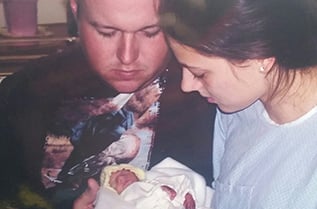 In 2019, SC Governor Henry McMaster visited GGC to sign Dylan’s Law, legislation that would add Krabbe disease to the state’s newborn screening test, also known as the heel prick test.
In 2019, SC Governor Henry McMaster visited GGC to sign Dylan’s Law, legislation that would add Krabbe disease to the state’s newborn screening test, also known as the heel prick test.
The law was named in memory of Dylan Emery, a GGC patient from Ninety Six, SC, who passed away from Krabbe disease at 11 months of age. His family worked with state legislators to add the rare disorder to the SC newborn screening panel allowing future affected infants to receive an early diagnosis with the hope of life-saving treatment. SC began screening for Krabbe disease on May 15, adding it to the panel of 55 other genetic disorders, becoming just the 11th state to test all newborns for this rare condition.
“Because newborn screening is not a diagnostic test, all positive screens from the state must be confirmed to distinguish truly affected infants from false positive cases,” said Francyne Kubaski, PhD, a staff scientist in GGC’s Biochemical Lab. “That’s where GGC comes in.”
Kubaski and her colleagues have been validating the testing of the biomarker psychosine to help with that process. Patients with Krabbe disease are unable to make an enzyme that breaks down psychosine. The buildup of psychosine in the central nervous system leads to the loss of myelin, a protective coating on the nerves, which causes significant neurological impairment.
Patients with Krabbe are typically asymptomatic at birth, but the disease can progress quickly. The infantile form begins with feeding difficulties, muscle weakness/stiffness, and fevers. As the disease progresses, patients may experience seizures, hearing and vision loss, nerve pain, and the inability to swallow and move, with death often occurring within two years.
Treatment for Krabbe disease includes bone marrow or stem cell transplantation which allows the patient to make more of the deficient enzyme, slowing progression of the disease. Once symptoms develop, it’s too late to reverse the damage that has already occurred which is why proponents have advocated adding Krabbe to the newborn screening panel.
Initial screening for all infants born in SC is performed at the state lab through dried blood spots taken from a heel stick. If the state lab identifies a low activity of the Krabbe enzyme, GGC will begin the confirmation process using these dried blood spots to test psychosine levels. By validating the testing using dried blood spots, this confirmatory testing can be performed quickly without obtaining a new sample.
 “It is important to include psychosine testing to confirm the diagnosis, as some individuals will display a low enzyme level in lab testing, but in actuality they are producing a sufficient amount enzyme,” said Kubaski. “This is called a pseudodeficiency, and does not cause disease.” But if enzyme levels are low and psychosine is elevated, that is a true positive result. GGC will then follow up with DNA sequencing of the gene responsible for Krabbe disease and patients are referred for consideration of a stem cell or bone marrow transplant.
“It is important to include psychosine testing to confirm the diagnosis, as some individuals will display a low enzyme level in lab testing, but in actuality they are producing a sufficient amount enzyme,” said Kubaski. “This is called a pseudodeficiency, and does not cause disease.” But if enzyme levels are low and psychosine is elevated, that is a true positive result. GGC will then follow up with DNA sequencing of the gene responsible for Krabbe disease and patients are referred for consideration of a stem cell or bone marrow transplant.
“For babies identified to have significantly elevated psychosine levels consistent with the infantile form of Krabbe disease, the time from diagnosis to treatment will be critical,” said Neena Champaigne, MD, Clinical Associate Professor and Division Chief of Pediatric Genetics at the Medical University of South Carolina. “The best outcome for survival requires they undergo stem cell transplant before 30 days of life. Coordination of care between the health department, primary care provider, specialists, the GGC laboratory and families will be key.”
Psychosine levels can also be measured on affected infants during treatment to determine if the transplanted stem cells are producing sufficient enzyme to decrease the toxic psychosine.
The Emery family has found comfort in knowing that Dylan’s legacy lives on. “We have always feared Dylan would be forgotten,” they shared. “We feel honored to be the parents of such a brave and amazing soul and are grateful to everyone who loved Dylan and helped put ‘Dylan’s Law’ into motion.”
“It is our hope that lives will be saved and other babies in South Carolina will have a better chance at survival if they are unfortunately diagnosed with this terrible disease,” added the Emerys.
